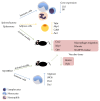Modulation of Immunity and Inflammation by the Mineralocorticoid Receptor and Aldosterone
- PMID: 26448944
- PMCID: PMC4581510
- DOI: 10.1155/2015/652738
Modulation of Immunity and Inflammation by the Mineralocorticoid Receptor and Aldosterone
Abstract
The mineralocorticoid receptor (MR) is a ligand dependent transcription factor. MR has been traditionally associated with the control of water and electrolyte homeostasis in order to keep blood pressure through aldosterone activation. However, there is growing evidence indicating that MR expression is not restricted to vascular and renal tissues, as it can be also expressed by cells of the immune system, where it responds to stimulation or antagonism, controlling immune cell function. On the other hand, aldosterone also has been associated with proinflammatory immune effects, such as the release of proinflammatory cytokines, generating oxidative stress and inducing fibrosis. The inflammatory participation of MR and aldosterone in the cardiovascular disease suggests an association with alterations in the immune system. Hypertensive patients show higher levels of proinflammatory mediators that can be modulated by MR antagonism. Although these proinflammatory properties have been observed in other autoimmune and chronic inflammatory diseases, the cellular and molecular mechanisms that mediate these effects remain unknown. Here we review and discuss the scientific work aimed at determining the immunological role of MR and aldosterone in humans, as well as animal models.
Figures



Similar articles
-
Mineralocorticoid receptor signaling: crosstalk with membrane receptors and other modulators.Steroids. 2014 Dec;91:3-10. doi: 10.1016/j.steroids.2014.05.017. Epub 2014 Jun 11. Steroids. 2014. PMID: 24928729 Review.
-
The role of the mineralocorticoid receptor in adipocyte biology and fat metabolism.Mol Cell Endocrinol. 2012 Mar 24;350(2):281-8. doi: 10.1016/j.mce.2011.09.011. Epub 2011 Sep 10. Mol Cell Endocrinol. 2012. PMID: 21945603 Review.
-
Mineralocorticoid Receptor and Aldosterone-Related Biomarkers of End-Organ Damage in Cardiometabolic Disease.Biomolecules. 2018 Sep 18;8(3):96. doi: 10.3390/biom8030096. Biomolecules. 2018. PMID: 30231508 Free PMC article. Review.
-
Corticosteroids, heart failure, and hypertension: a role for immune cells?Endocrinology. 2012 Dec;153(12):5692-700. doi: 10.1210/en.2012-1780. Epub 2012 Nov 2. Endocrinology. 2012. PMID: 23125312 Review.
-
Rapid mineralocorticoid receptor trafficking.Steroids. 2014 Mar;81:103-8. doi: 10.1016/j.steroids.2013.10.016. Epub 2013 Nov 16. Steroids. 2014. PMID: 24252381
Cited by
-
The interplay of renal potassium and sodium handling in blood pressure regulation: critical role of the WNK-SPAK-NCC pathway.J Hum Hypertens. 2019 Jul;33(7):508-523. doi: 10.1038/s41371-019-0170-6. Epub 2019 Feb 5. J Hum Hypertens. 2019. PMID: 30723251 Review.
-
The Correlation Between Aldosterone and Leukocyte-Related Inflammation: A Comparison Between Patients with Primary Aldosteronism and Essential Hypertension.J Inflamm Res. 2023 Jun 5;16:2401-2413. doi: 10.2147/JIR.S409146. eCollection 2023. J Inflamm Res. 2023. PMID: 37304156 Free PMC article.
-
The Cl-/HCO3- exchanger pendrin is downregulated during oral co-administration of exogenous mineralocorticoid and KCl in patients with primary aldosteronism.J Hum Hypertens. 2021 Oct;35(10):837-848. doi: 10.1038/s41371-020-00439-7. Epub 2020 Nov 10. J Hum Hypertens. 2021. PMID: 33173144
-
Inhibitory Effects of Oxymatrine on Transdifferentiation of Neonatal Rat Cardiac Fibroblasts to Myofibroblasts Induced by Aldosterone via Keap1/Nrf2 Signaling Pathways In Vitro.Med Sci Monit. 2019 Jul 20;25:5375-5388. doi: 10.12659/MSM.915542. Med Sci Monit. 2019. PMID: 31325292 Free PMC article.
-
Blocking mineralocorticoid signaling with esaxerenone reduces atherosclerosis in hyperglycemic ApoE KO mice without affecting blood pressure and glycolipid metabolism.Sci Rep. 2025 Mar 29;15(1):10887. doi: 10.1038/s41598-025-95324-z. Sci Rep. 2025. PMID: 40157997 Free PMC article.
References
-
- Marver D., Kokko J. P. Renal target sites and the mechanism of action of aldosterone. Mineral and Electrolyte Metabolism. 1983;9(1):1–18. - PubMed
Publication types
MeSH terms
Substances
LinkOut - more resources
Full Text Sources
Other Literature Sources

